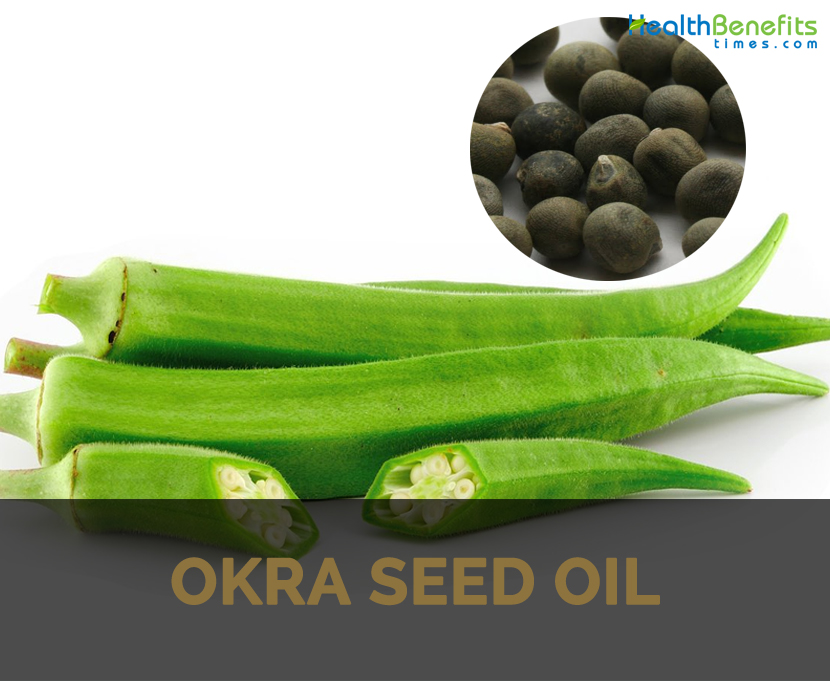| Okra seed oil uses and benefits Quick Facts | |
|---|---|
| Name: | Okra seed oil uses and benefits |
| Scientific Name: | Abelmoschus esculentus |
| Origin | It is widely grown in West Africa especially Nigeria. It was originated in Ethiopia and was propagated by 12th century BC in North Africa, Arabia, Mediterranean and India. |
| Colors | Bright yellow with greenish tinge |
History
It is widely grown in West Africa especially Nigeria. It was originated in Ethiopia and was propagated by 12th century BC in North Africa, Arabia, Mediterranean and India. It is commercially grown in Japan, India, Western Africa, Iran, Turkey, Bangladesh, Yugoslavia, Pakistan, Afghanistan, Thailand, Malaysia, Myanmar, Brazil, India, Cyprus, Ethiopia and Southern United States. The seed pods were cooked and seeds were roasted or ground and also used as a substitute for coffee. In 1700s, it reached to U.S. and Caribbean and was brought from West Africa by slaves and soon after, it was introduced to Western Europe. Creoles learned to cook okra for thickening soups from slaves in Louisiana. Due to its increased popularity, the pods have gained respect as a vegetable in the country U.S.
Precautions
- The people who have kidney stones and irritable bowel syndrome should not use it.
- Before use, consult the doctor to remain on the safe side.
- Use it in moderate amounts.
- Sensitive people might get allergic reactions.
Okra seed oil facts
Okra seed oil is a common edible oil that is extracted with the use of solvent extraction method and could also be used as a substitute for cotton seed oil. It is also used for the production of vanspati.
| Name | Okra seed oil uses and benefits |
|---|---|
| Scientific Name of Okra | Abelmoschus esculentus |
| Native | It is widely grown in West Africa especially Nigeria. It was originated in Ethiopia and was propagated by 12th century BC in North Africa, Arabia, Mediterranean and India. It |
| Common/English Name of Okra | Lady’s finger, Gumbo, Ochro , Bamia pod |
| Name in Other Languages of Okra | England: lady’s finger; USA: gumbo; Portuguese: guibeiro; India: bhindi; Thailand: krajiab kheaw; South East Asia: okra plant, okoro, ochro, quimgombo, gombo, quingumbo, kopi, kacang bendi, arab, bhindi; Middle East: asbamia, bamieh, bamya; Angola: quiabo; Cuba: quimbombo; Sweden: mbinda, mbamia; Taiwan: qiu kui; Croatian: jedilna oslez; Danish: okra; Greek: Bamia, bamies; Hebrew: hibiscus ne’echal, bamiya; Hindi: bhindee, bandakai, dheras, vendakai; Hungarian: bámia, gombó; Italian: gombo, bammia d’egitto, ocra, corna di greci; Japanese: amerika neri, okura, kiku kimo; Khmer: pôôt barang; Korean: oh k’u ra; Laotian: khüa ngwàng; Malay: bendi, kacang lender, kacang bendi, sayur bendi , kachang bendi, kacang lendir, kopi arab; Norwegian: grønsakhibisk; Polish: ketmia jadalna, czyli okra; Portuguese: gambô, quibombô, quiabo, quibombó; Romanian: bame; Russian: bamiia; Sanskrit: tindisa; Spanish: gombo, quimbombo, ají turco, ruibarbo, ocra; Tamil: vendaikkaay; Thai: krachiap, krachiap khieo, ton krachiap, bakhua mun, krachiap mon; Turkish: bamya; Urdu: bhindii; Nepali: van lasun (वन लसुन); Manipuri: Belendri; Albanian: bamje; Basque: okra; Belarusian: okra (окра); Bosnian: okra; Bulgarian: bamya (бамя); Catalan: okra; Croatian: okra; Czech: okra; Danish: okra; Dutch: okra; Estonian: okra; Finnish: Okra; French: gombo; Galician: Quiabo; German: Okra; Greek: bámia (μπάμια); Hungarian: gombó; Icelandic: okra; Irish: okra; Italian: gombo; Latvian: Okras; Lithuanian: okra; Macedonian: bamja (бамја); Maltese: Okra; Norwegian: okra; Polish: róża chińska; Portuguese: quiabo; Romanian: okra; Russian: okra (окра); Serbian: okra (окра); Slovak: okra; Slovenian: Bamija; Spanish: okra; Swedish: okra; Ukrainian: okra (окра); Welsh: ocra; Yiddish: okra (אָקראַ); Armenian: okra; Azerbaijani: bamya; Bengali: Akarā (অকরা); Chinese: Qiū kuí (秋葵); Georgian: okra; Gujarati: Ōkarā (ઓકરા); Hmong: okra; Kannada: Beṇḍekāyi (ಬೆಂಡೆಕಾಯಿ); Kazakh: Bamïya (Бамия); Khmer: okra; Korean: okeula (오크라); Lao: phik (ພິກ); Malayalam: okra; Marathi: Bhēṇḍī (भेंडी); Mongolian: chukhal kheregtseetei (чухал хэрэгцээтэй); Myanmar (Burmese): ronepatesee (ရုံးပတီသီး); Nepali: okra; Sinhala: baṇḍakkā (බණ්ඩක්කා); Tajik: okra; Tamil: okra; Telugu: Ōkrā (ఓక్రా); Thai: Mak̄heụ̄xmxỵ (มะเขือมอญ) Uzbek: Bomiyon; Vietnamese: đậu bắp; Arabic: bamia (بامية); Turkish: bamya; Afrikaans: okra; Chichewa: there’re; Hausa: okra; Igbo: okra; Sesotho: okra; Somali: okra; Swahili: bamia; Yoruba: okra; Zulu: okra; Cebuano: okra; Filipino: okra; Indonesian: okra; Javanese: okra; Malagasy: okra; Malay: bendi; Maori: okra; Esperanto: okra; Haitian Creole: kalalou; Latin: okra |
| Extraction method | Solvent extraction method |
| Color | Bright yellow with greenish tinge |
| Odor | Fragrant |
Comments
comments
